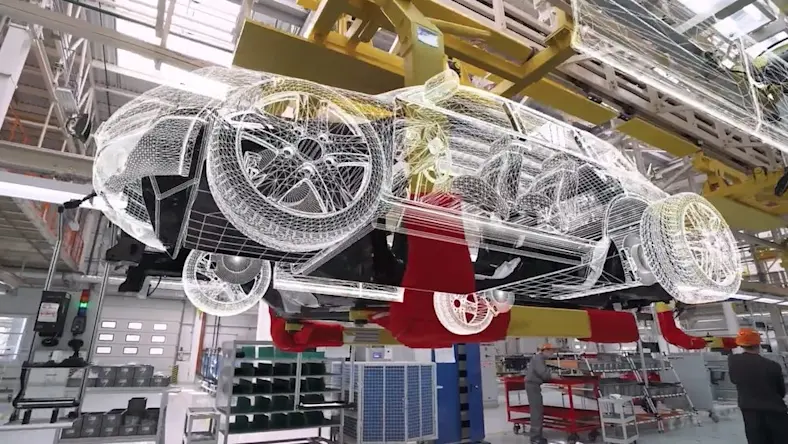& Construction

Integrated BIM tools, including Revit, AutoCAD, and Civil 3D
& Manufacturing

Professional CAD/CAM tools built on Inventor and AutoCAD
Automated manufacturing: It’s a term that conjures gigantic factories churning out thousands of identical products, often owned by multinational conglomerates for whom agility is a major (and expensive) undertaking.
But what about small businesses? They can pivot quickly in response to markets, but how can they access the economic efficiency that automation offers? Enter distributed manufacturing.
Distributed manufacturing is a process in which the materials and fabrication are decentralized, making the processes more accessible, customizable, and affordable. Products are made close to clients, cutting down transportation and storage costs. Because companies rely on smaller, local manufacturers to produce their products, even turnaround times can be much faster.
Two engineers are forging this new path in manufacturing, creating a business case for putting automation in the hands of smaller organizations and educating users about the possibilities. Betsy and Mike Jasper met at Georgia Tech, where they both studied mechanical engineering, but their subsequent expertise couldn’t be more different, with each branching into areas as disparate as aerospace, energy, power hydraulics, helicopter gearboxes, and more. Their skills complement each other and make them ideal candidates to help small businesses adopt automated manufacturing.
The Jaspers’ Boston-based company, Tarkka (the Finnish word for exact), is on a mission to democratize mechanical engineering and manufacturing by disseminating knowledge and developing precision products.
“Right now, there’s kind of a barrier to entry for manufacturing,” Betsy says. “There’s a huge cost to acquire machines or work in a machine shop if you want to develop your own product or start a business. We’re working on a flexible, modular platform that will have a reasonable budget so anyone can either make their own machines or make their own products using our machines.”
As residents at the Autodesk Technology Center in Boston, the Jaspers use the 34,000-square-foot facility to its fullest. Although access to the workshops, prototyping studio, and design and manufacturing software helps tremendously, aligning with the greater residency community of engineers, designers, and Autodesk’s industry experts also plays a crucial role in Tarkka’s ambitions.
One important avenue for the Jaspers is their proprietary system of self-contained actuator modules and effectors called Modular Motion. Actuator modules allow precise positioning of workpieces or effector modules on a production line. Effectors perform basic assembly tasks like pick-and-place, fastening, inspection, and marking—repetitive, exact, and sometimes risky actions that robots do much better than humans.
Tarkka’s modular set of rails and universal connectors lets users plug in an end effector (3D-print head, milling spindle, electronics pick-and-place device, gripper, and so on) or create their own custom end effector. As any engineer knows, the characteristics of a good milling machine aren’t necessarily the same as those for a good pick-and-place machine. That means Modular Motion has to cover a much wider domain of uses.
The Tarkka system will be available to small manufacturers and will drastically decrease the tooling-up load needed to start production. “We’re going to have lots of resources to help anybody—even nontechnical or creative people—get into digital fabrication,” Mike says.
The Jaspers’ aim is to reduce the time, money, and knowledge required to build automated manufacturing machines. But providing the right tool is only half the job. Tarkka introduces small businesses to automated manufacturing at the microscale (and holds their hands while they learn how to use it) through instructional videos published on its YouTube channel, covering all kinds of small-manufacturing questions and processes.
“There was a big knowledge gap between what I saw at a larger company versus a smaller company,” Mike says. “That level of mentorship wasn’t there at smaller companies, so it’d be nice to have the kind of skill set you learn on the job through mentorship available for everybody.”
Betsy adds that having done plenty of professional training themselves, she and Mike wanted their educational videos to be a bit different. “We’re trying to walk that fine line of enough analytical information to be valuable, not really about hacking things together, but to be very practical, grounded, real-world examples to give context,” she says.
Educational videos and Modular Motion are the pointy end of a wider philosophy of connecting big-factory traditional manufacturing styles with small manufacturers. For one thing, Tarkka is going to make the electrical-connection board open source to be easy for users to design whatever mechanical part they need. In a very real sense, there’s no upper limit because the modularity of the system is hugely scalable.
But one of the main paradigm changes Tarkka stands to contribute to with its work is the concept of distributed manufacturing. As Betsy says, even hobbyists or home-based makers can accept contracts to take on a single part or a build that’s part of a much larger product.
“One of the big things in manufacturing right now is high variety with low volume,” Betsy says. “We’re all talking about personalization. The way the media is changing to on-demand streaming is overflowing into other parts of our life—we want products that are individually tailored to very small markets.”
That means distributed-manufacturing supply chains aren’t just viable; they might also be a pivotal part of the new manufacturing and design culture. “The manufacturing supply chain has to match this high mix, low volume,” Betsy says. “Right now, companies are making tens or hundreds of thousands of one thing. They do a piece in one step, and then it goes to another machine for the next step. We’re rethinking that. If we can reconcile those two processes, we can have outsourcing and collaboration at a very micro-manufacturing scale.”
Central to its business model, Tarkka is spearheading its own inclusiveness mandate. Whether a person is a maker, student, hobbyist, hacker, or professional (as the website says), the Jaspers bring automated manufacturing down from its huge factory smokestacks and put it within a user’s grasp.
This article has been updated. It was originally published in February 2020.
After growing up knowing he wanted to change the world, Drew Turney realized it was easier to write about other people changing it instead. He writes about technology, cinema, science, books, and more.
Emerging Tech
Emerging Tech
D&M







